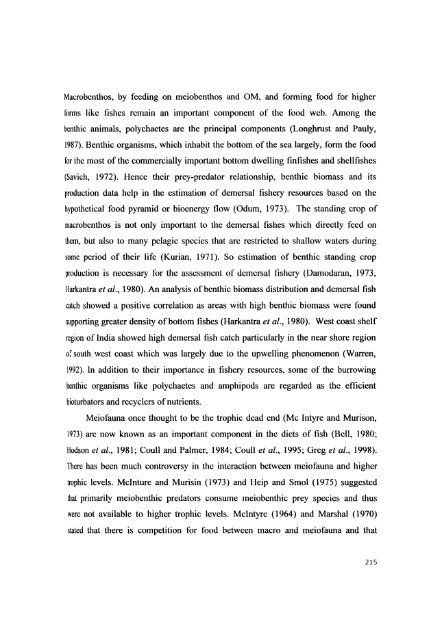L - Cochin University of Science and Technology
L - Cochin University of Science and Technology
L - Cochin University of Science and Technology
Create successful ePaper yourself
Turn your PDF publications into a flip-book with our unique Google optimized e-Paper software.
Macrobenthos, by feeding on meiobenthos <strong>and</strong> OM. <strong>and</strong> fonning food for higher<br />
fonns like fishes remain an important component <strong>of</strong> the food wcb. Among the<br />
bcnthic animals, polychaetes are the principal components (Longhrust <strong>and</strong> Pauly,<br />
1987). Benthic organisms, which inhabit the bottom <strong>of</strong> the sea largely, fonn the food<br />
for the most <strong>of</strong> the commercially important bottom dwelling finfishes <strong>and</strong> shellfishes<br />
(Savich, 1972). Hence their prey-predator relationship, benthic biomass <strong>and</strong> its<br />
production data help in the estimation <strong>of</strong> demersal fishery resources based on the<br />
hypothetical food pyramid or bioenergy flow (Odum, 1973). The st<strong>and</strong>ing crop <strong>of</strong><br />
macrobenthos is not only important to the demersal fishes which directly feed on<br />
them, but also to many pelagic species that are restricted to shallow waters during<br />
some period <strong>of</strong> their life (Kurian, 1971). So estimation <strong>of</strong> benthic st<strong>and</strong>ing crop<br />
production is necessary for the assessment <strong>of</strong> demersal fishery (Damodaran, 1973,<br />
Harkantra et al., 1980). An analysis <strong>of</strong> benthic biomass distribution <strong>and</strong> demersal fish<br />
catch showed a positive correlation as areas with high benthic biomass were found<br />
supporting greater density <strong>of</strong> bottom fishes (Harkantra et al., 1980). West coast shelf<br />
region <strong>of</strong> India showed high demersal fish catch particularly in the near shore region<br />
0; south west coast which was largely due to the upwelling phenomenon (Warren,<br />
1992). In addition to their importance in fishery resources, some <strong>of</strong> the burrowing<br />
benthic organisms like polychaetes <strong>and</strong> amphipods are regarded as the efficient<br />
bioturbators <strong>and</strong> recyclers <strong>of</strong> nutrients.<br />
Mei<strong>of</strong>auna once thought to be the trophic dead end (Mc Intyre <strong>and</strong> Murison,<br />
1973) are now known as an important component in the diets <strong>of</strong> fish (Bell, 1980;<br />
Hodson et al., 1981; Coull <strong>and</strong> Palmer, 1984; Coull et al., 1995; Greg et al., 1998).<br />
There has been much controversy in the interaction between mei<strong>of</strong>auna <strong>and</strong> higher<br />
trophic levels. Mc1nture <strong>and</strong> Murisin (1973) <strong>and</strong> Heip <strong>and</strong> Smol (1975) suggested<br />
that primarily meiobenthic predators consume meiobenthic prey species <strong>and</strong> thus<br />
were not available to higher trophic levels. Mc1ntyre (1964) <strong>and</strong> Marshal (1970)<br />
stated that there is competition for food between macro <strong>and</strong> mei<strong>of</strong>auna <strong>and</strong> that<br />
21.5

















